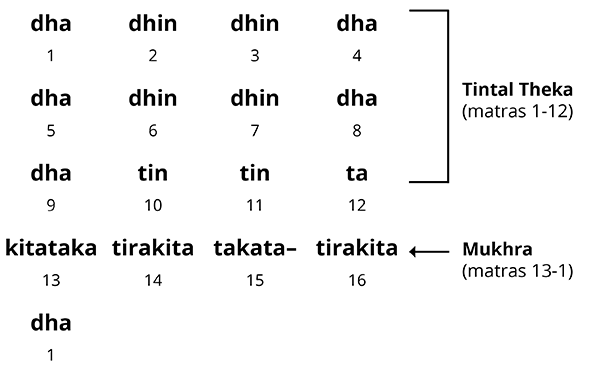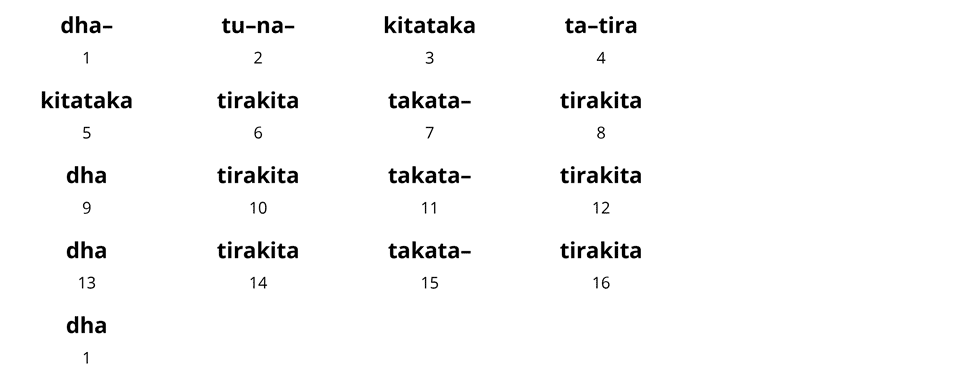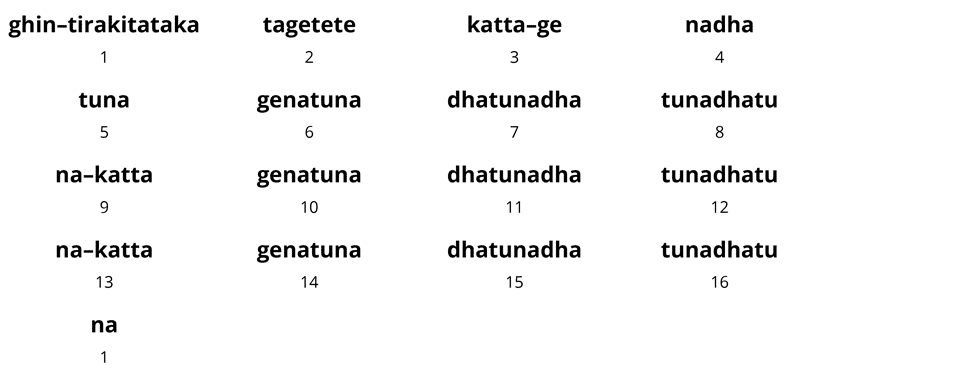Mukhṛā/Mohrā – मुखड़ा/मोहरा
Quick Definition: a phrase which builds up to the sam (the 1 of the tal), with or without a tihai. For some, mukhra and mohra are the same. For others, a mohra must contain a tihai.
Literal Meanings:
- Mukhra: mouth; front; face
- Mohra: front; face
Mukhra/Mohra Examples
4-Matra Mukhra/Mohra
This mukhra/mohra starts on matra 13 of the tintal theka:

Performed 3 times with theka:
Performed 4 times at faster speed:
(from Tintal – 4-Matra Mukhra 1)
16-Matra Mukhra/Mohra (sam to sam)
This kind of mukhra/mohra includes a tihai, and so it may also be called a tukra (discussed below):

Performed without theka:
Performed 3 times with theka at faster speed:
(from Benares Tukra 2)
Introduction to Mukhra/Mohra
Mukhra and mohra are cadential phrases which build up to the sam, the 1 of the tal. They are generally short, such as the first example above. However some are longer, such as the second example. These are essentially the same as a tukra, which we look at in the next section.
For some musicians, mukhra and mohra are the same thing. For others, they are different.
According to most who say that they are different, a mohra has a tihai, but a mukhra does not. So of the two examples above, the first would be a mukhra, and the second a mohra.
In the lineage of Chhotelal Misra, mukhra and mohra are the same thing. So a mukhra may, or may not, have a tihai. On this website, I will use the term mukhra for both.
For some, the term mukhra may also refer to the opening section of a tukra, uthan,or paran. This is not exactly the same as the mukhra we look at here. See the Tukra Section for a discussion.
Mukhra builds up to the sam
The mukhra builds up to the sam (the 1 of the tal) with a concise cadential statement that creates tension.
When a mukhra is short, it is functionally similar to a drum fill in Western popular music; it creates tension, and then resolution, by finishing on the 1.
Listen to two more mukhras below in tintal, a 16-beat cycle. Like the first example above, each mukhra is four beats long plus dha (finishing on sam of the next cycle), so they begin on the 13th beat of the cycle. It is helpful if you can already follow the tintal theka. Each mukhra is performed 4 times:
(from Benares Mukhra 4.2)
(from Benares Mukhra 4.3)
Mukhra Bols
All kinds of different bols (phrases) are used to create mukhras. However, some of the most common mukhras are made from tirakita-type bols, such as in Mukhra 4.1, Mukhra 4.2 and Benares Tukra 2 given above. Every gharana teaches mukhra/mohras that are very similar to these.
For those who say a mohra must include a tihai, then there may be specific kinds of bols that are commonly used, or it may be restricted to a particular length.
But such restrictions appear to be gharana-specific, so there is no agreement on the definition.
Mukhra, mohra, tukra, and uthan definitions may overlap
The differences between mukhra, mohra, tukra, and uthan are not always clear.
In the tradition of Chhotelal Misra, the mukhra given above which includes a tihai is defined both as a mukhra and as a tukra in his books.
Other players may also use the terms mukhra, mohra, and tukra interchangeably, depending on the performance context.
For example, the following composition is a well-known tukra played in all gharanas. But Keramatullah Khan (former head of the Farrukhabad gharana) calls this a mohra in his book 42 Lessons for Tabla:

Listen to Keramatulla Khan speak and perform this mohra[1]:
It may be that Keramatullah Khan also performed this as a tukra. But when used as an opening piece, as in his book, he calls it a mohra.
In Chhotelal Misra’s book Tabla Granth, he calls this composition a tukra (p. 83). But he also mentions that it may be performed an an uthan.
Uthan is another form that may overlap with mohra and tukra, especially in gharanas where the uthan is a short tukra-type composition used to open a tabla solo, or to begin the tabla’s accompaniment. (This issue is discussed more in the sections on the tukra and uthan.)
So students and listeners should be flexible about the terms mukhra, mohra, tukra, and uthan. As we can see, they are used in a variety of related ways by different players and gharanas.
References
Khan, Keramatullah. 42 Lesson for Tabla. New York City: Folkways Records and Services corp., 1973.
Kippen, James. The Tabla of Lucknow – A Cultural Analysis of a Musical Tradition. Cambridge: Cambridge University Press, 1988.
Misra, Chhote Lal. Tal Prabandh. New Delhi: Kanishka Publishers, 2006. (Hindi)
—. Tabla Granth. New Delhi: Kanishka Publishers, 2006. (Hindi)
Stewart, Rebecca Marie. The Tabla in Perspective. Unpublished Ph.D. thesis, University of California, Los Angeles, 1974.
- This audio excerpt is presented for educational purposes only under the Fair Use doctrine. ↩